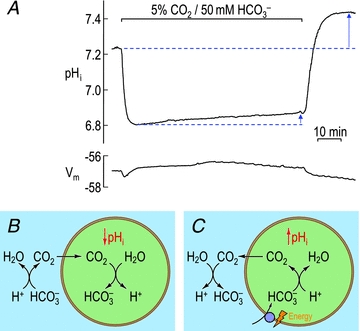XB-IMG-125581
Xenbase Image ID: 125581

|
Figure 2. Effect of extracellular CO2/HCO−3 on intracellular pH of a squid giant axon, showing data (A), model of acidifying phase (B) and model of alkalinization during plateau phase (C)Throughout the experiment in A, ASW with an extracellular pH of 7.70 flowed past a cannulated axon, which was suspended in a chamber of small volume. Intracellular pH and membrane potential were monitored with glass microelectrodes. During the indicated period, the ASW was switched to one equilibrated with 5% CO2 and in which 50 mm NaHCO3 replaced 50 mm NaCl. Data are from Boron & De Weer (1976b). B shows that the influx of CO2 leads to the production of intracellular H+ and thus a fall in pHi. This process accounts for the falling phase of pHi during the CO2/HCO−3 exposure in A. The influx of CO2 in B leads to the indicated reaction near the extracellular surface of the membrane. In the bulk (i.e. flowing) ASW, the CO2/HCO−3 buffer was in equilibrium (CO2+ H2O ⇌ H++ HCO−3). C shows the system after CO2 has equilibrated across the cell membrane; this equilibration corresponds to the pHi nadir during the CO2/HCO−3 pulse. After this equilibration, pHi is dominated by ‘acid extrusion’, shown here as the active uptake of HCO−3. This active uptake of HCO−3 is mediated by a transporter called a Na+-driven Cl−–HCO−3 exchanger (which may mediate uptake of CO32− or NaCO3− ion pair). This HCO−3 uptake had been occurring since the beginning of the CO2/HCO−3 exposure, but its effect on pHi had been overwhelmed by the influx of CO2. Now, during the plateau phase, HCO−3 uptake leads to a consumption of H+ in the cytosol and thus the production of CO2, leading to a net efflux of CO2. This process accounts for the plateau-phase alkalinization (i.e. rising phase of pHi) during the CO2/HCO−3 exposure in A. Because the cell accumulated HCO−3 during the CO2/HCO−3 exposure, the removal of extracellular CO2/HCO−3 leads to a pHi overshoot. Image published in: Boron WF (2010) © 2010 The Physiological Society. Creative Commons Attribution license Larger Image Printer Friendly View |
